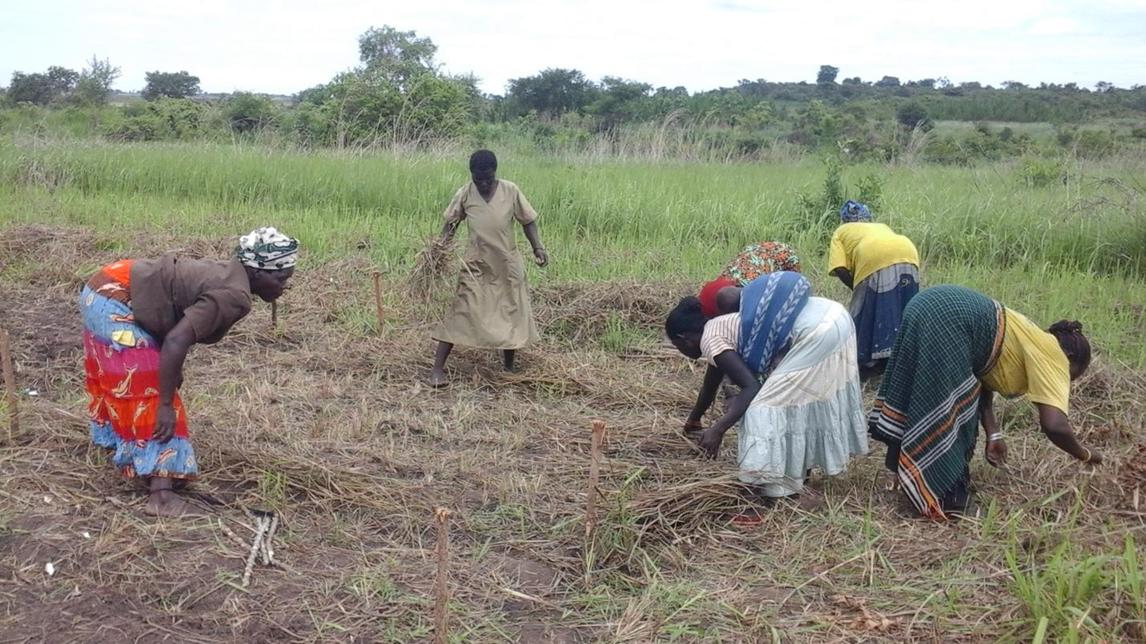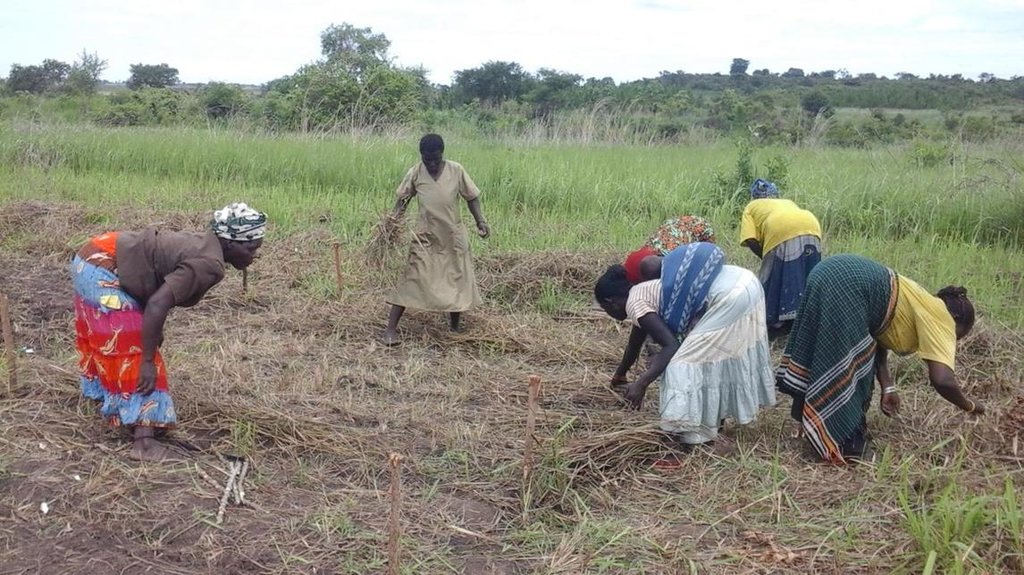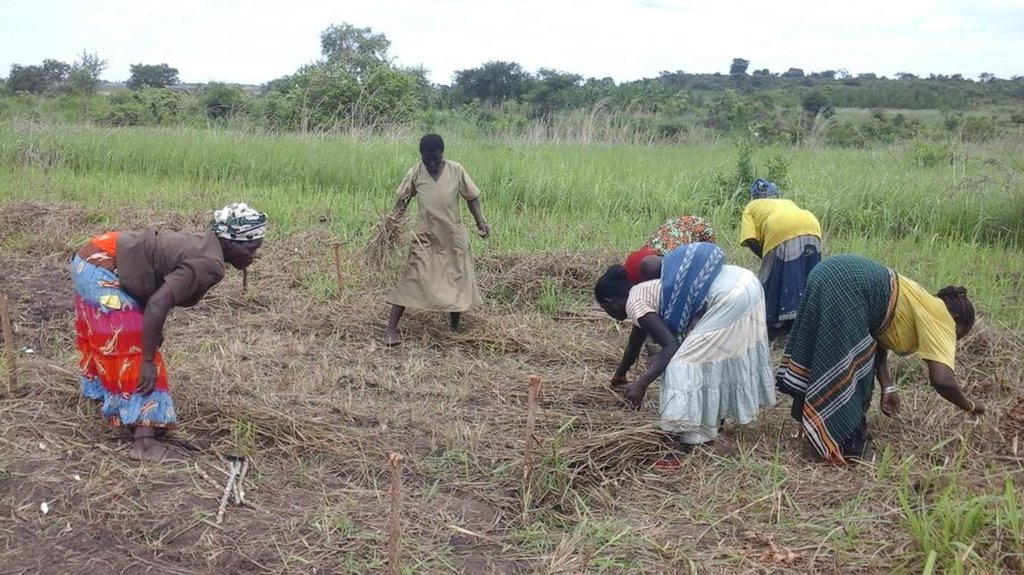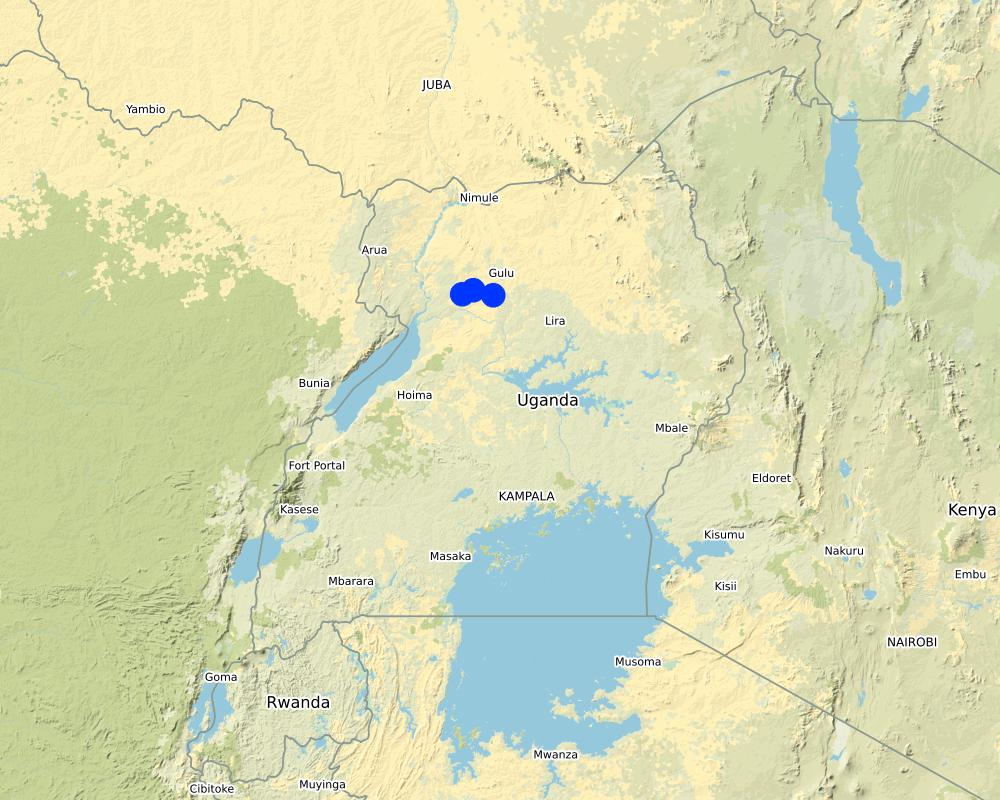Reducing Tillage by Slashing [乌干达]
- 创建:
- 更新:
- 编制者: Sunday Balla Amale
- 编辑者: Kamugisha Rick Nelson, JOY TUKAHIRWA, betty adoch, Bernard Fungo
- 审查者: John Stephen Tenywa, Nicole Harari, Luigi Piemontese, Udo Höggel
lum ajwera
technologies_3329 - 乌干达
查看章节
全部展开 全部收起1. 一般信息
1.2 参与该技术评估和文件编制的资源人员和机构的联系方式
关键资源人
土地使用者:
Aryemo Eveline
Farmer
Obul Village, Lii Sub county, Nwoya District
乌干达
有助于对技术进行记录/评估的项目名称(如相关)
Scaling-up SLM practices by smallholder farmers (IFAD)有助于对技术进行记录/评估的机构名称(如相关)
Makerere University (Makerere University) - 乌干达1.3 关于使用通过WOCAT记录的数据的条件
(现场)数据是什么时候汇编的?:
12/07/2017
编制者和关键资源人员接受有关使用通过WOCAT记录数据的条件。:
是
1.4 所述技术的可持续性声明
这里所描述的技术在土地退化方面是否存在问题,导致无法被认为是一种可持续的土地管理技术?:
否
2. SLM技术的说明
2.1 技术简介
技术定义:
A minimum tillage technology where the garden is cleared by slashing and crops are planted without opening the land. Only the spot where the seed is planted is dug. The rest of the land is left undisturbed.
2.2 技术的详细说明
说明:
Soil tillage, which is practiced traditionally to prepare fine seedbeds and control weeds, bears several undesirable side effects that have forced land users to rethink and develop other sustainable management strategies such as reduced tillage or no-till (see photo below). Tillage as a practice damages soil and leaves it exposed to erosion, particularly by wind and water. Yet weeding using tillage methods is often laborious and costly. In parts of northern Uganda, minimum or reduced tillage is used to ease land preparation.
Labor is an important factor that determines the size of gardens that farmers can prepare and work on. With this technology, immediately after crop harvest, the field is cleared by slashing residues (weeds and crop residues) present in the field. It is a good practice to cut the vegetation before they produce seeds to ensure that few weed seeds germinate. After slashing down crop residues, planting holes for the subsequent crop are dug following the given recommendations for the crop to be planted.
This practice ensures that the residues provide mulch, which in turn reduces surface runoff and soil erosion. The decomposing residues provide humus and replenish nutrients into the soil. Plants can also escape harsh weather conditions since they can be planted in time. This technology is still new among the farming communities in northern Uganda, thus its proper use requires extension advisory support.
2.3 技术照片
2.5 已应用该技术的、本评估所涵盖的国家/地区/地点
国家:
乌干达
区域/州/省:
Nothern
有关地点的进一步说明:
Nwoya district
注释:
The three sites in Nwoya were demonstrations established by CIAT/IITA on CSA practices which included minimun tillage
Map
×2.6 实施日期
注明实施年份:
2015
2.7 技术介绍
详细说明该技术是如何引入的:
- 通过土地使用者的创新
- 通过项目/外部干预
3. SLM技术的分类
3.1 该技术的主要目的
- 改良生产
- 保护生态系统
- 保持/提高生物多样性
- 适应气候变化/极端天气及其影响
- 创造有益的经济影响
- ensure early planting
3.2 应用该技术的当前土地利用类型

农田
- 一年一作
3.3 有关土地利用的更多信息
该技术所应用土地的供水:
- 雨养
每年的生长季节数:
- 2
具体说明:
Two rainy seasons
3.4 该技术所属的SLM组
- 改良的地面/植被覆盖
- 最小的土壤扰动
3.5 技术传播
具体说明该技术的分布:
- 适用于特定场所/集中在较小区域
3.6 包含该技术的可持续土地管理措施

农艺措施
- A1:植被和土壤覆盖层

植物措施
- V2:草和多年生草本植物
3.7 该技术强调的主要土地退化类型

土壤水蚀
- Wt:表土流失/地表侵蚀

土壤风蚀
- Et:表土流失

化学性土壤退化
- Cn:肥力下降和有机质含量下降(非侵蚀所致)

生物性退化
- Bh:栖息地丧失
- Bq:数量/生物量减少
- Bl:土壤寿命损失
3.8 防止、减少或恢复土地退化
具体数量名该技术与土地退化有关的目标:
- 减少土地退化
- 适应土地退化
4. 技术规范、实施活动、投入和成本
4.2 技术规范/技术图纸说明
Grasses are slashed to ground surface. Only the spot onwhich the seed is to be planted is dug to create conditions for good germination.
4.3 有关投入和成本计算的一般信息
具体说明成本和投入是如何计算的:
- 每个技术单元
指定单位:
acre
指定体积、长度等(如果相关):
30x160m2
其它/国家货币(具体说明):
uganda shillings
注明美元与当地货币的汇率(如相关):1美元=:
3600.0
注明雇用劳工的每日平均工资成本:
5000
4.4 技术建立活动
| 活动 | 措施类型 | 时间 | |
|---|---|---|---|
| 1. | Slashing | 管理 | dry season |
注释:
This is an activity in replacement to land preparation by tillage
4.5 技术建立所需要的费用和投入
| 对投入进行具体说明 | 单位 | 数量 | 单位成本 | 每项投入的总成本 | 土地使用者承担的成本% | |
|---|---|---|---|---|---|---|
| 劳动力 | Personnel | persondays | 9.0 | 5000.0 | 45000.0 | 100.0 |
| 设备 | Slashes | pieces | 3.0 | 6000.0 | 18000.0 | 100.0 |
| 技术建立所需总成本 | 63000.0 | |||||
注释:
Farmer can use hoes instead of slasher for slashing the grass. If grasses are tall and mature, the farmer prefers to use a hand hoe of equivalent cost
4.6 维护/经常性活动
注释:
This technology is not maintained, it is repeated. That is it is to be done prior to every planting season.
4.7 维护/经常性活动所需要的费用和投入(每年)
注释:
This technology is not maintained, it is repeated every season
4.8 影响成本的最重要因素
描述影响成本的最决定性因素:
Farm labour, although this technology reduces the labour demand in general
5. 自然和人文环境
5.1 气候
年降雨量
- < 250毫米
- 251-500毫米
- 501-750毫米
- 751-1,000毫米
- 1,001-1,500毫米
- 1,501-2,000毫米
- 2,001-3,000毫米
- 3,001-4,000毫米
- > 4,000毫米
有关降雨的规范/注释:
Two rainy seasons in a year, dry season between December and March
注明所考虑的参考气象站名称:
Gulu Meteorological Station
农业气候带
- 半湿润
5.2 地形
平均坡度:
- 水平(0-2%)
- 缓降(3-5%)
- 平缓(6-10%)
- 滚坡(11-15%)
- 崎岖(16-30%)
- 陡峭(31-60%)
- 非常陡峭(>60%)
地形:
- 高原/平原
- 山脊
- 山坡
- 山地斜坡
- 麓坡
- 谷底
垂直分布带:
- 0-100 m a.s.l.
- 101-500 m a.s.l.
- 501-1,000 m a.s.l.
- 1,001-1,500 m a.s.l.
- 1,501-2,000 m a.s.l.
- 2,001-2,500 m a.s.l.
- 2,501-3,000 m a.s.l.
- 3,001-4,000 m a.s.l.
- > 4,000 m a.s.l.
说明该技术是否专门应用于:
- 不相关
5.3 土壤
平均土层深度:
- 非常浅(0-20厘米)
- 浅(21-50厘米)
- 中等深度(51-80厘米)
- 深(81-120厘米)
- 非常深(> 120厘米)
土壤质地(表土):
- 中粒(壤土、粉土)
土壤质地(地表以下> 20厘米):
- 细粒/重质(粘土)
表土有机质:
- 中(1-3%)
5.4 水资源可用性和质量
地下水位表:
5-50米
地表水的可用性:
中等
水质(未处理):
不良饮用水(需要处理)
水的盐度有问题吗?:
否
该区域正在发生洪水吗?:
否
5.5 生物多样性
物种多样性:
- 中等
栖息地多样性:
- 中等
5.6 应用该技术的土地使用者的特征
定栖或游牧:
- 定栖的
生产系统的市场定位:
- 生计(自给)
非农收入:
- 低于全部收入的10%
相对财富水平:
- 贫瘠
个人或集体:
- 个人/家庭
机械化水平:
- 手工作业
性别:
- 女人
土地使用者的年龄:
- 青年人
- 中年人
5.7 应用该技术的土地使用者拥有或租用的平均土地面积
- < 0.5 公顷
- 0.5-1 公顷
- 1-2 公顷
- 2-5公顷
- 5-15公顷
- 15-50公顷
- 50-100公顷
- 100-500公顷
- 500-1,000公顷
- 1,000-10,000公顷
- > 10,000公顷
这被认为是小规模、中规模还是大规模的(参照当地实际情况)?:
- 小规模的
5.8 土地所有权、土地使用权和水使用权
土地所有权:
- 个人,未命名
土地使用权:
- 个人
用水权:
- 社区(有组织)
5.9 进入服务和基础设施的通道
健康:
- 贫瘠
- 适度的
- 好
教育:
- 贫瘠
- 适度的
- 好
技术援助:
- 贫瘠
- 适度的
- 好
就业(例如非农):
- 贫瘠
- 适度的
- 好
市场:
- 贫瘠
- 适度的
- 好
能源:
- 贫瘠
- 适度的
- 好
道路和交通:
- 贫瘠
- 适度的
- 好
饮用水和卫生设施:
- 贫瘠
- 适度的
- 好
金融服务:
- 贫瘠
- 适度的
- 好
6. 影响和结论性说明
6.1 该技术的现场影响
社会经济效应
生产
作物生产
注释/具体说明:
More land can be opened
作物质量
注释/具体说明:
Better crop growth
生产区域
SLM之前的数量:
1acre
SLM之后的数量:
2acre
注释/具体说明:
more land can be opened
土地管理
注释/具体说明:
Reduced soil erosion
收入和成本
农业投入费用
注释/具体说明:
Less expenses on land opening
农业收入
注释/具体说明:
due to increased production
工作量
注释/具体说明:
Primary and secondary tillage reduced to just slashing
6.2 该技术的场外影响已经显现
水资源可用性
注释/具体说明:
Grasses retain more water so that more water is in the soils
6.3 技术对渐变气候以及与气候相关的极端情况/灾害的暴露和敏感性(土地使用者认为的极端情况/灾害)
渐变气候
渐变气候
| 季节 | 气候变化/极端天气的类型 | 该技术是如何应对的? | |
|---|---|---|---|
| 年降雨量 | 减少 | 非常好 | |
| 季雨量 | 湿季/雨季 | 减少 | 好 |
气候有关的极端情况(灾害)
气候灾害
| 该技术是如何应对的? | |
|---|---|
| 干旱 | 非常好 |
生物灾害
| 该技术是如何应对的? | |
|---|---|
| 昆虫/蠕虫侵扰 | 适度 |
6.4 成本效益分析
技术收益与技术建立成本相比如何(从土地使用者的角度看)?
短期回报:
积极
长期回报:
非常积极
技术收益与技术维护成本/经常性成本相比如何(从土地使用者的角度看)?
短期回报:
积极
长期回报:
非常积极
注释:
In real sense, this technology its not maintained but it is done each and every season for annual crops for land clearence
6.5 技术采用
- 1-10%
在所有采用这项技术的人当中,有多少人是自发地采用该技术,即未获得任何物质奖励/付款?:
- 90-100%
6.6 适应
最近是否对该技术进行了修改以适应不断变化的条件?:
否
6.7 该技术的优点/长处/机会
| 土地使用者眼中的长处/优势/机会 |
|---|
| Reduction of labour demands |
| More land can be cleared |
| Less farm activities |
| 编制者或其他关键资源人员认为的长处/优势/机会 |
|---|
| Reduction in soil disturbance hence increase in soil life |
6.8 技术的弱点/缺点/风险及其克服方法
| 土地使用者认为的弱点/缺点/风险 | 如何克服它们? |
|---|---|
| more weeds | proper control of weeds, before they produce seeds |
| 编制者或其他关键资源人员认为的弱点/缺点/风险 | 如何克服它们? |
|---|---|
| Leached nutrients are not brought to surface | plant deep rooted crops |
7. 参考和链接
7.1 信息的方法/来源
- 实地考察、实地调查
3
- 与土地使用者的访谈
1
- 与SLM专业人员/专家的访谈
1
链接和模块
全部展开 全部收起链接
无链接
模块
无模块





